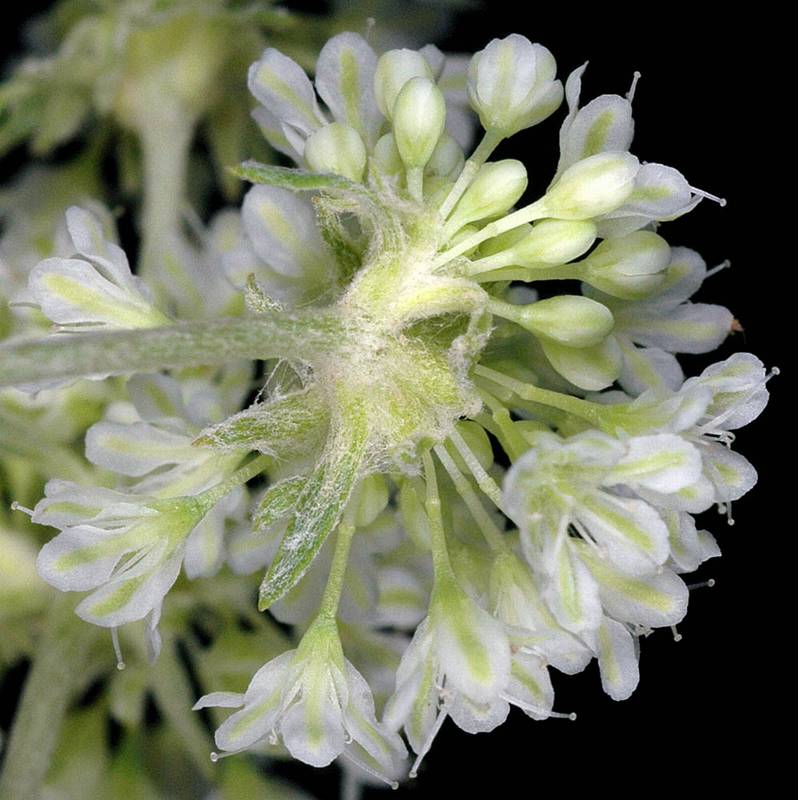|
bractless parsnip-flowered wild buckwheat, parsnip-flowered buckwheat, parsnip-flowered eriogonum
|
snow buckwheat
|
| Perennial with a branched, woody base forming clumps up to 6 dm. broad and 4 dm. high, generally white-woolly throughout. |
Freely-branched perennial with a woody base, occasionally prostrate, but usually erect, the many branches forming a clump up to 4 dm. tall and wide. |
Numerous, basal, on petioles several times as long as the blade; blades linear-lanceolate to broadly oblanceolate, grayish-lanate on both surfaces or only sparsely tomentose and much less grayish above. |
Leaves tufted, mostly basal, 1.5-6 cm. long, the blade oblong-ovate to broadly lanceolate, about the same length as the petiole, densely gray-woolly on both sides. |
Peduncles 10-30 cm. long, usually with several leafy bracts about mid-length; inflorescence a compound umbel with narrow bracts at the base; involucres woolly, cup-shaped, the several lobes 2-3 mm. long; tepals white to cream, occasionally pinkish, glabrous externally, with a stipe-like base 1-3 mm. long. |
Flowering stems are several times di- or trichotomously branched, forming a large inflorescence that is gray-woolly throughout. Involucres 3-4 mm. long, conic, usually with 3 erect teeth, borne singly throughout the inflorescence and subtended by a pair of leafy bracts. Tepals 6, cream to pink, 3-4 mm. long, the outer segments oblong and twice as broad as the inner segments. |
|
3-angled achene |
|
|
|
|
| The whorl of bracts at mid-stem is a good identifying feature if they are present, but they are often lacking in Kittitas, Chelan and Douglas Counties. The long, narrow, woolly leaves are distinctive in those areas |
The leafy bracts below the flowers throughout the inflorescence separates E. niveum from the similar E. strictum, which has no leafy bracts. |
| May-July |
June-September |
| Deeper soil of shrub-steppe to ponderosa pine forests and rocky ridges at middle elevation in the mountains. |
Sagebrush desert, dry ponderosa pine forest openings, in deep or sandy soil. |
Occurring east of the Cascades crest in Washington; British Columbia to California, east to Montana, Wyoming and Colorado.
|
Occurring east of the Cascades crest in Washington; British Columbia to Oregon, east to Idaho.
|
| Native |
Native |
| Not of concern |
Not of concern |
E. baileyi, E. cernuum, E. codium, E. compositum, E. douglasii, E. elatum, E. flavum, E. maculatum, E. marifolium, E. microtheca, E. niveum, E. nudum, E. ovalifolium, E. pyrolifolium, E. sphaerocephalum, E. strictum, E. thymoides, E. umbellatum, E. vimineum |
E. baileyi, E. cernuum, E. codium, E. compositum, E. douglasii, E. elatum, E. flavum, E. heracleoides, E. maculatum, E. marifolium, E. microtheca, E. nudum, E. ovalifolium, E. pyrolifolium, E. sphaerocephalum, E. strictum, E. thymoides, E. umbellatum, E. vimineum |
| |



